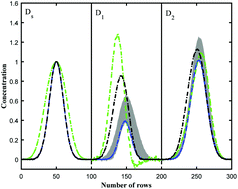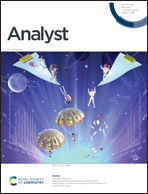Soft-trilinear constraints for improved quantitation in multivariate curve resolution†
Abstract
Nowadays, hyphenated chemical analysis methods like GC/MS, LC/MS, or HPLC with UV/Vis diode array detection are widely used. These methods produce a data matrix of mixtures measured during the analytical process. When a set of samples is to be analyzed with one data matrix per sample, the data is often presumed to have “trilinear” structure if the profile for each compound does not change shape or position from one sample to the other. By applying this information as a trilinearity constraint in Self Modeling Curve Resolution (SMCR) methods, overlapping peaks related to the pure compounds of interest can be resolved in a unique way. In practice, many systems have non-trilinear behavior due to deviation from ideal response, for example, a sample matrix effect or changes in instrumental response (e.g., shifts or changes in the shape of chromatographic peaks). In such cases, the trilinear model is not valid because every analyte does not have the same peak shape or position in every sample. In such cases, the unique profiles obtained by strictly enforced trilinearity constraints will not necessarily produce true profiles because the data set does not follow the assumed trilinear behavior. In this work, we introduce “soft-trilinearity constraints” to permit peak profiles of given components to have small deviations in their shape and position in different samples. The advantages and disadvantages of this approach are compared to other methods like PARAFAC2. We illustrate the influence of soft-trilinearity constraints on the accuracy of SMCR results for the case of a 3-component simulated system and an experimental data set. The results show that implementing soft-trilinearity constraints reduces the range of possible solutions considerably compared to the application of constraints such as just non-negativity. In addition, we show that the application of hard-trilinearity constraints can lead to solutions that are completely wrong or exclude the opportunity of a possible solution at all.



 Please wait while we load your content...
Please wait while we load your content...